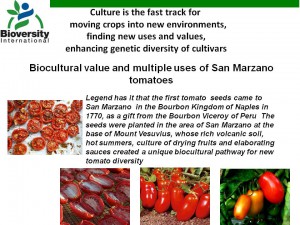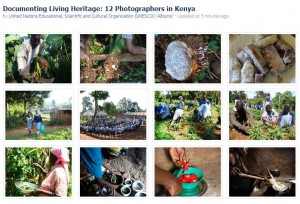- Genetic diversity of Brassica oleracea var. capitata gene bank accessions assessed by AFLP. Czech genebank; subgroups reflected place of origin.
- Optimizing the cropping mix in North Darfur State, Sudan. A study of Umkdada district. “…the results of the model were different from the real practices of the farmers.” Oh dear. To improve the fit, schoolboys should work in the fields more. And crops should fetch more. The dismal science indeed.
- Climate-driven simulation of global crop sowing dates. Ok, this model works. You can predict sowing dates under rainfed conditions for various annual crops from climatic conditions. Not entirely sure why you would want to, though.
- Exploring some of the myths of land use change: Can rural to urban migration drive declines in biodiversity? Yes, counter-intuitively, at least in the forests of Mexico’s southwestern highlands. More from Conservation Magazine.
- Pollination services in the UK: How important are honeybees? Quite a bit, but maybe not as much as previously thought. It’s the wild bees, stupid!
- Genetic diversity and symbiotic effectiveness of rhizobia isolated from root nodules of Phaseolus vulgaris L. grown in soils of Iran. It is high, and it varies, respectively.
- Interspecific hybridization of fig (Ficus carica L.) and Ficus erecta Thunb., a source of Ceratocystis canker resistance. It’s a breakthrough!
- Exploring the diversity of urban and peri-urban agricultural systems in Sudano-Sahelian West Africa: An attempt towards a regional typology. There are 6 types. Not 5; not 7. On this one, the journey is more interesting than the destination.
- Variability of wild olives (Olea europaea subsp. europaea var. sylvestris) analyzed by agro-morphological traits and SSR markers. There’s a lot of variabzzzzzzzzzz…
- Hemp in ancient rope and fabric from the Christmas Cave in Israel: Talmudic background and DNA sequence identification. Mainly flax, but some hemp, from both Roman and Chalcolithic periods. But can you smoke it?
- Modelling the distribution of domestic ducks in Monsoon Asia. Low resolution data, plus fancy modelling, can be used to get pretty good high resolution predictions.
- Gene flow between wheat and wild relatives: empirical evidence from Aegilops geniculata, Ae. neglecta and Ae. triuncialis. It happens, a lot.
- Toward food system sustainability through school food system change: Think&EatGreen@School and the making of a community-university research alliance. Food citizenship?
- Simulation of winter wheat yield and its variability in different climates of Europe: A comparison of eight crop growth models. Big differences among models, so best thing to do is to use the mean of all of them.
- The potential of plant viruses to promote genotypic diversity via genotype × environment interactions. The negative effect of White Clover Mosaic Virus (WCMV) infection on performance differs from white clover genotype to genotypes, which means differential selection, which means negative frequency-dependent selection in host populations, which means diversity. Via.
- Amplifying the benefits of agroecology by using the right cultivars. Why should we summarize, when an author has already done so?
Nibbles: Spatial data, poverty, Livestock diseases, Romania, Cultural diversity, Iraqi marshes, Citizen science , Biohappiness, Beer!
- The CGIAR spatial crowd get it together? Not holding my breath.
- So tell me about that biodiversity-poverty link. Well, more research is, ahem, needed. Wet, for want of a better word.
- All the different kinds of “spots” for livestock diseases. How did they cope with the poor data? And have the various hotspots and coldspots been considered in drawing up the new research priorities for livestock?
- UNDP stumps up $4 million to plan biodiversity management in Romania. Including agrobiodiversity? Not holding my breath.
- A socio-economic impact analysis of cultural diversity in cities does not consider agriculture at all. There’s a PhD there for someone.
- IUCN’s plans for the Iraqi marshes. Thesiger unavailable for comment.
- If it can be done with amphibians, why the hell can’t it be done with agricultural biodiversity?
- Biojoy swamps Bioversity as Biohappiness book is launched.
- Yeah but was there any of this? And if not, why not? Via NWFP-Digest-L.
Can biodiversity research change the future of agriculture?
 Our friend, colleague and, apparently, occasional reader Pablo Eyzaguirre, an anthropologist at Bioversity International, by all accounts gave a barnstorming performance in an internal seminar recently, but alas all that is available of it at the moment for those of us who were not there is his PowerPoint presentation, whose title we have stolen for this post. That is, of course, better than nothing, and I’m certainly not complaining. 1
Our friend, colleague and, apparently, occasional reader Pablo Eyzaguirre, an anthropologist at Bioversity International, by all accounts gave a barnstorming performance in an internal seminar recently, but alas all that is available of it at the moment for those of us who were not there is his PowerPoint presentation, whose title we have stolen for this post. That is, of course, better than nothing, and I’m certainly not complaining. 1
It’s worth going through the whole thing, imagining Pablo in full flood. But if one were to boil his argument down to essentials, something that I feel sure Pablo himself would abhor, it might go something like this, and I use Pablo’s own words from the slides, only slightly re-arranged:
- You cannot solve problems with the same mentality that created them: intensification through simplification and increased inputs.
- Agrobiodiversity provides an answer as a source of inputs to address the problems arising from simplification of agriculture and depletion of the natural resource base.
- But diverse traditional agricultural systems are also crucibles for the development of innovative new ways of producing food linking agriculture more responsively to consumers and emerging movements on food culture, health and territory, and building on synergies among crop varieties, species and breeds, wild and cultivated spaces.
- So where can we find, and scale out, the new models for bio-intensification and increased resilience in agriculture? Where local institutions and knowledge systems exist to embed, govern and transmit the value and potential of their agricultural biodiversity and biocultural landscapes to young people and allies in conservation and development.
Well, there’s much more to the presentation than that, of course, and lots of wonderful examples to reinforce each point. Go check it out for yourself. And Pablo, if you’re reading this, maybe you’d like to write a summary for your fellow readers?
The question it leaves me with is this: with no agrobiodiversity “megaprogramme” in the CGIAR, will there be enough of the “alternative” mentality around to take up Pablo’s gauntlet?
Safeguarding tangible agricultural heritage
 There’s a great set of pictures of Kenyan traditional crops and food preparation on UNESCO’s Facebook page, in their Documenting Living Heritage series. This is part of an exhibition currently on at UNESCO’s HQ in Paris to raise awareness of the 2003 Convention for the Safeguarding of Intangible Cultural Heritage. I doubt there’s a photograph of the Gene Bank of Kenya, but that surely contributes to that goal too.
There’s a great set of pictures of Kenyan traditional crops and food preparation on UNESCO’s Facebook page, in their Documenting Living Heritage series. This is part of an exhibition currently on at UNESCO’s HQ in Paris to raise awareness of the 2003 Convention for the Safeguarding of Intangible Cultural Heritage. I doubt there’s a photograph of the Gene Bank of Kenya, but that surely contributes to that goal too.
Feria del Elote
From CIMMYT’s Flickr feed:
Carts selling tacos made with maize tortillas (traditional Mexican flatbreads) in Jala, Nayarit, on the Pacific coast of Mexico, during the town’s annual two-week Feria del Elote, or maize ear festival. Tortillas are a staple food in Mexico, and are commonly filled to make tacos. For more about maize in Jala, see CIMMYT’s August 2007 e-news story “Pride and pragmatism sustain a giant Mexican maize,” available online.
Photo credit: Eloise Phipps/CIMMYT.
